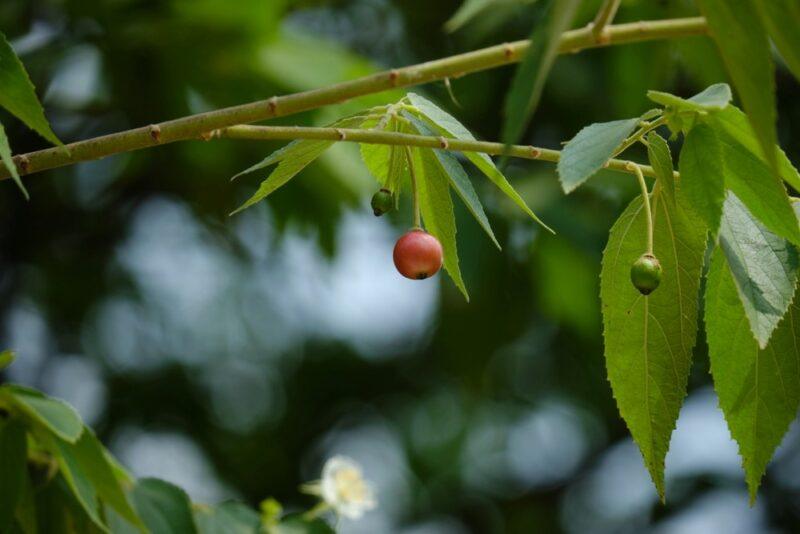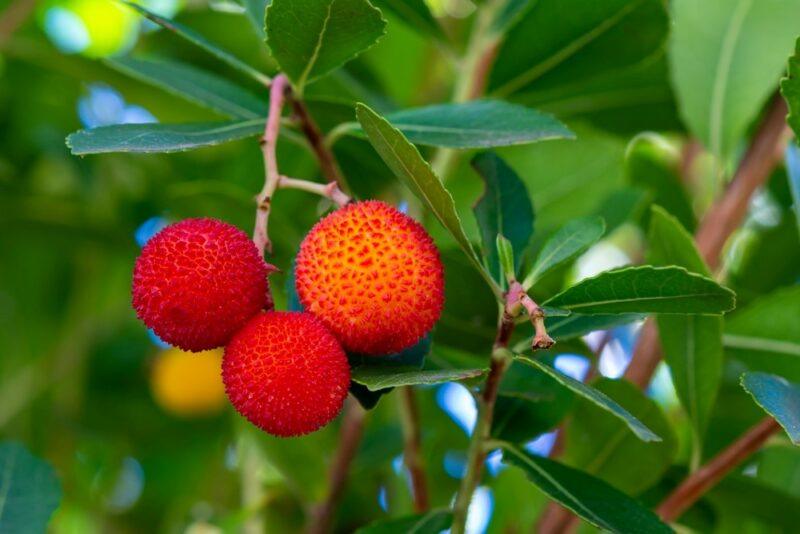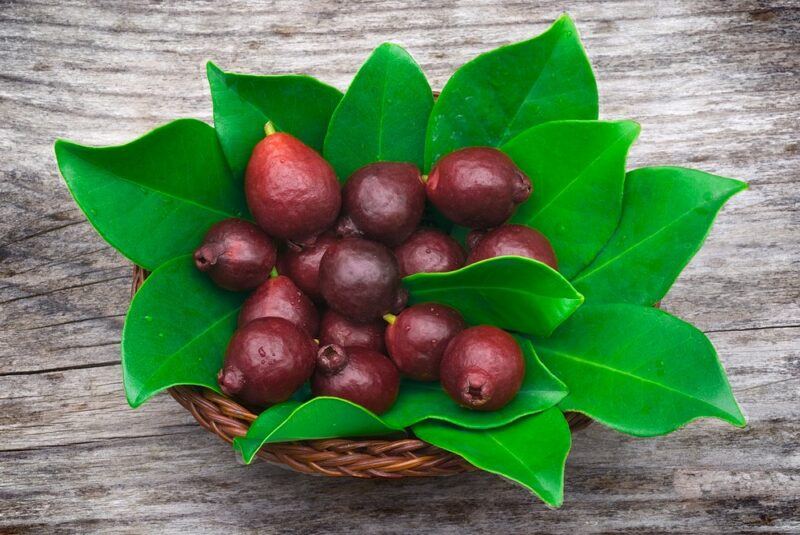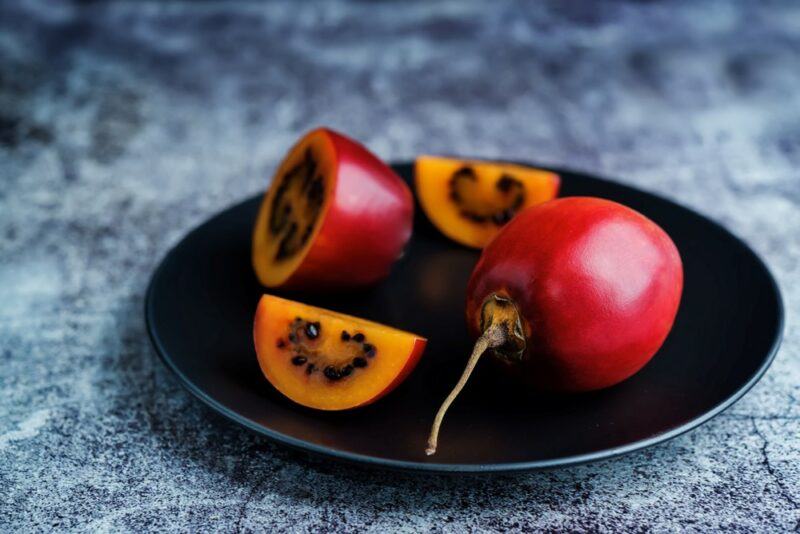
Fruits are both exciting and fascinating. They come in a shocking number of shapes, flavors, and textures, including styles that you may have never seen before. Seriously. Our full exotic fruits list is now at close to 100 entries and we’re still just scratching the surface. Today we’re taking a narrower look and just considering exotic red fruits.
Why the red fruits? Partly because we’ve already covered green and yellow ones, but also because looking at just one color makes some of the other differences much more obvious.
Don’t assume we’re just talking about berries and apples though. There’s a surprising variety of interesting red fruit from many parts of the world. You’ll see some Asian, some Mexican, and some Hawaiian fruits on the list, along with some you may never have seen before.
Some of these fruits can be found online or in exotic fruit boxes, but many aren’t sold commercially at all. You might also be able to grow the fruit yourself, if you live in the right climate and can find a supplier that focuses on exotic seeds and cuttings. Otherwise, you might be stuck ogling the pictures – at least until you can get to the country in question.
Exotic Red Fruits You’ve Never Seen Before (With Pictures!)
Barbados Cherries

These bright fruits aren’t actually cherries in the traditional sense. You’ll notice this immediately after trying one, as they typically contain three small pits rather than a single stone.
While the fruit does taste a little like cherries, some of the flavors are more reminiscent of apples or plums instead. There’s a notable tartness as well, although you’ll still notice sweet notes (especially when the cherries are fully ripe).
The cherries are unusual, so you won’t often see them for sale in the United States. However, some nurseries do offer cuttings of the trees, allowing you to grow them yourself at home.
Yangmei

These fruits are sometimes nicknamed Chinese bayberry, but other times get called yumberry instead. The latter name is perfect, as the fruits truly are delicious.
Their flavor profile is somewhere between a raspberry and a strawberry, but the flavor is also tarter and slightly more herbal than most berries. The texture is interesting too, as the fruits tend to be surprisingly chewy.
Some care is needed, as the fruits do tend to harbor pests or dirt. The best way around this is to soak them in salt water first. This ensures that they’re safe to eat.
One more thing. While yangmei fruits are very similar to berries, they do contain a small seed in the center. It’s important to watch out for this when you’re eating the fruit – much like you would with a cherry seed.
Dragon Fruit

Dragon fruit often has a dark pink-red skin, with either white or purple pulp on the inside. The fruit doesn’t just look amazing either. It also has a delightful subtle flavor that is a little like watermelon, pear, and kiwi all rolled into one.
This combination of tastes makes dragon fruit refreshing, particularly in contrast to excessively sweet fruits. That said, sometimes a dragon fruit that tastes like nothing at all. This is normally because it was picked too early and didn’t have the time to fully ripen.
Jacote

Like many fruits, jacotes are green then gradually increase in color as they ripen. Some varieties ripen to yellow, while others turn red or purple as they become ripe.
The fruit is sometimes described as the Jamaican plum or hog plum, which isn’t surprising, as the ripe fruits are similar to the traditional plum. They can be eaten in the same way too or used in a variety of recipes. In particular, jacote can be used as the base of a sweet syrup or honey, one that can be enjoyed as a dessert or paired with other foods.
Alternatively, the fruit can be used unripe instead. Here the flavors are much tarter and somewhat bitter, making jocote particularly useful in a sauce. Some people still eat the fruit directly, often paired with chili peppers and salt.
Phalsa Berry

Don’t these little berries look amazing? Sometimes they’re a deep purple, but you’ll often see red versions as well. The fruits have an amazing sweet and sour balance of flavor, which makes them useful in many recipes.
The berries are also famous for their potential health benefits. This is partly due to the high levels of antioxidants and other plant-based compounds, which could all have positive impacts. More studies are needed to know exactly how the berries help, but current results are very promising.
Japanese Barberry

As the name suggests, Japanese barberries do come from Japan. However, the plant is also incredibly common in the east of the United States, to the extent that it’s becoming a serious issue.
The invasive nature of the plant means that you shouldn’t try to grow it at home. However, you may be able to forage for the berries.
The fruit is interesting, as there’s only a little sweetness, along with plenty of bitter flavor notes. The bitterness is distinct enough that you probably wouldn’t eat the fruit on its own (or, at least, would stop after just a few berries). The Japanese barberry is much more attractive when included as an ingredient in jams, drinks, and pies instead.
Pitaya

The pitaya looks incredibly similar to the dragon fruit and even has the same flavor profile. Despite this, the two fruits actually come from different genera (pitaya belongs to the Stenocereus genus, while dragon fruit comes from the Hylocereus genus instead).
The similarities between the fruits mean you can use them interchangeably. You may even see them sold under the wrong names occasionally.
Jamaican Strawberry

Jamaican strawberries (Muntingia calabura) are a delicious sweet fruit that tastes a little like cotton candy. They’re not related to strawberries at all and don’t look much like them either. Instead, the fruits hang from a tree much like little cherries.
The trees are often grown ornamentally. This is partly because of the leaves and shape of the tree, and partly because of how beautiful the berries look, especially when they are fully ripe.
Strawberry Tree

Confusingly, both this species (Arbutus unedo) and the previous entry are sometimes known as the strawberry tree. This time, the bright fruits do look somewhat like little strawberries, so the name isn’t completely unexpected.
Despite being often grown ornamentally, strawberry tree fruits are entirely edible. The texture is surprisingly similar to a cherry, despite the differences in the fruit’s skin. As for flavor, the fruit tends to have a refreshing sweet-sour balance that’s easy to enjoy.
Mountain Apple

Like many fruits, this treat goes by many names, including rose apple, wax apple, water apple, and mountain apple. While the fruit looks a little like an apple from the outside, the interior is completely different.
For one thing, the flesh of the rose apple is much looser than a true apple, with a texture that’s closer to watermelon than to an apple. The flavor is different too, with plenty of sweetness and distinct floral notes.
Despite all the differences between these and apples, they can be eaten in exactly the same way. They’re often used in cooking and preserves as well, particularly because the fruit is highly perishable and doesn’t transport well.
Barberry

These bright red berries are often associated with health benefits, but they’re also deliciously tart. They can be used fresh or dried, often as a way to add distinction to a recipe.
You’ll often see these show up in both sweet and savory dishes, including Iranian pilaf. There are a few varieties of barberries and these vary in flavor and use. Because of this, it’s worth doing a little research first and working out the best type of barberry for your needs.
Miracle Fruit

Miracle fruit is incredibly unusual, as it contains a chemical that influences the way we experience flavor. In particular, after eating miracle fruit, sour flavors taste sweet for an hour or so. It’s an odd effect indeed and one that doesn’t cause any harm.
Eating miracle fruit right before a meal could completely change your experience. You might even design a menu or event with the miracle fruit in mind.
Strawberry Guava

These fruits really are what the name suggests. They’re similar to regular guavas, except that they’re generally red and have strawberry nuances to their flavor profile. Many people even prefer them to regular guavas.
Strawberry guava trees can be appealing to gardeners too, as they’re generally easier to grow than regular guava trees and handle a variety of climates. There’s a catch though – in some warm climates strawberry guava trees grow a bit too well. They’re even considered an invasive species and can disrupt native plants.
So, if you’re looking at planting strawberry guava for yourself, it’s important to make sure you can do so without harming your local environment.
Lychee

Lychees are interesting fruits. They’re getting more common these days, but are still exotic and quite unexpected.
Underneath the red knobby skin of the fruit is soft white flesh that encloses a fairly large seed. The texture is similar to a grape, which may be surprising given the toughness of the exterior shell. As for flavor, you’re looking at a musky and aromatic balance.
While lychees are often eaten fresh, you can also find them dried or canned. Such versions are easier to transport than the fresh fruit and still taste good.
Red Persimmon

Persimmons are generally orange, but did you know that there are red ones as well? The honan red persimmon is one example. These permissions are best enjoyed fully ripe, as they are astringent up till this point.
This variety originally came from China, but was introduced to the United States early in the 1900s. It’s an excellent option for anyone who is a little bored of conventional persimmons.
Tamarillo

Tamarillos also go by the name tree tomato. That name probably relates to the external appearance of the fruit, as the interior and flavor of the fruit isn’t much like a tomato at all.
Original tamarillo strains mostly produced purple or yellow fruits. Red fruited varieties tend to be much more common these days and are popular in many parts of the world, including the United States, New Zealand, Peru, and Columbia.
Prickly Pear

Eating fruit from a cactus is an odd idea, yet is a surprisingly common practice. Doing so involves a decent amount of care and effort, as the cactus fruit have many glochids.
These glochids are small barbed hairs that are often found near spines. They’re painful and all but invisible, which is a nasty combo. You’ll need tongs or gloves to handle the fruit safely, plus a knife to cut the skin from the fruit or a gas torch to burn off the glochids.
Once prepared, the fruit can be delicious and may even offer health benefits.
Rambutan

Rambutan fruits look a little like sea urchins growing on a tree. Their distinct spines are actually green while the fruit is growing. A few days after harvesting they turn red instead.
The interior of the fruit is quite different. It includes white translucent flesh that’s much like a lychee. This flesh is creamy, with a flavor that’s similar to grapes. As such, it’s an easy fruit to enjoy – even if it does look strange.
Che

These little fruits are also known as Mandarin melon berries and look a little like large raspberries. They have a bumpier skin than raspberries though and are also chewier.
Some people say that the flavor profile is similar to fresh figs, while others say it’s closer to a mulberry and fig cross. This isn’t too surprising, as the plant is related to figs. While you won’t often find these berries in local stores, they can be grown at home.
Pitanga

The pitanga tree belongs to the myrtle family and is often grown for ornamental purposes. The berries tend to be sweet when they’re dark red or close to black and tarter when they’re orange. However, the flavor profile does vary somewhat based on the cultivar.
The fruit can easily be eaten fresh or it can be cooked with, like making jello or even wine. While you may not find the berries locally, growing them yourself is certainly possible. Care is needed, though, as the plant is invasive in some areas.
Ackee

Ackee is a fruit to be careful with, as you shouldn’t ever eat it raw. Still, when ackee is prepared well and cooked, the fruit really can be delicious.
Ackees are particularly common in Jamaican and Caribbean cuisine, where the fruit features in a variety of dishes, such as curries and stews.
Pulasan

This fruit should look incredibly familiar, as the appearance is much like the rambutan from earlier. However, the two fruits aren’t the same. Pulasans lack the spines that rambutans have and also tend to be sweeter.
People who have tried both types of fruit often say that pulasans are the best, partly because their flavor is more complex. However, there are always differences between varieties and individual plants. Personal preference is a factor as well.
Finger Lime

Finger limes don’t look exciting from the outside, just like elongated limes that are occasionally red or yellow, rather than green. The interior is much more unexpected, as the fruits are filled with tiny globes of fruit juice.
The flavor is much like that of a regular lime, with some lemon nuances added in. You’ll often hear the term citrus caviar, which is an apt way of describing the juice globes. You can use the juice globes much like you would pomegranate arils, which includes scattering them on a salad or even using them as part of a cocktail.
Achiote

Achiote is a little different than most of the fruits on this list, as it is typically used to make food dye, rather than being eaten as a fruit itself (the fruit isn’t edible as such).
While achiote was once used for clothing dye, it is now more common as a natural food coloring – which can then be used with countless foods, including rice and even butter.
Goji Berries

Goji berries are pretty famous these days, as they’ve become popular as a superfruit, one that’s rich in antioxidants and could provide many health benefits.
Most of the time you’ll find either dried or powdered goji berries rather than fresh ones. The berries also feature in many different superfood blends. The berries can be eaten fresh, but they’re very perishable and don’t travel well.
The berries taste good as well. They are generally sweet, with a touch of sourness in their flavor profile.
Red Salak

Salak is an interesting fruit with a skin that looks almost like the scales of a snake. Not surprisingly, red salak is similar, except that the skin is red (while regular salaks tend to have brown skin).
The skin is easily removed to reveal white flesh. This flesh is generally sweet, with a notable acidity that makes the fruits even more interesting. Red salak isn’t commonly cultivated, so it’s a fruit you may struggle to find in markets or even at nurseries.
Hawthorn

Hawthorn berries don’t look like much. They’re simply small and red, looking like many other fruits. However, they’re an interesting choice, as they have a delicious tart flavor with just enough sweetness.
The berries can be safely eaten raw, used in desserts, fermented to make wine, or dried to make hawthorn tea. There are also hawthorn berry supplements, which could offer some health benefits. However, the supplements only sometimes include hawthorn berries. Some just focus on dried flowers and leaves instead.
Jujube

Finally, we have jujube fruits. These are small, red, and somewhat wrinkled fruits that can be enjoyed fresh or dried. Jujube fruits aren’t easy to find in the United States, but some specialty stores may stock the dried versions. You could also order them online.

















 33 Exotic Asian Fruits To Tempt And Delight
33 Exotic Asian Fruits To Tempt And Delight
Leave a Reply